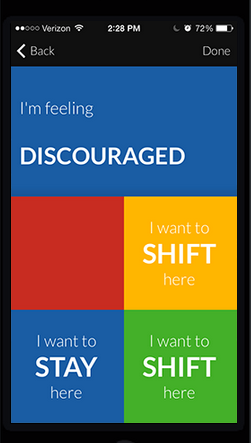
YOU KNOW THE OLD SONG, IF YOU can make it here … you can pay $8k a month for a one-bedroom and still step over a Starbucks cup in the vestibule, squeeze nose-to-armpit into the 6 train and feel poor no matter your fancy title or big salary. Why is everyone here so smart, successful and loaded all the time?
Everyone isn’t, of course, and those who are didn’t necessarily start out that way.
Despite the daily abuse the city can dole out, wave after wave of optimistic strivers move here each year, fueled just by their dreams. For those determined—even stubborn—souls, is there a more irresistible place than New York—a city with new as its first name?
To celebrate their aspiration and talent, we present an exhibit, curated by our resident experts, of emerging people, objects and ideas you should know about this year.
There is a mood-altering app and a lifesaving invention, a burlesque upstart and a brain-probing scientist, a breakout singer from humble origins in South America, as well as an increasingly prominent socialite with the city’s most recognizable surname.
Taken together, they represent the intelligence, ingenuity and sheer mojo that define this city as a beacon for creatives of all stripes. Because no matter how high the rent gets, New York always loves the next big thing.— David Wallis
THE NEXT BIG LIFESAVER

From the second floor of a small Brooklyn building, Joe Landolina, co-founder of the biotech company Suneris, leads a team of researchers developing VetiGel, an invention that can almost magically stop severe bleeding in seconds. Whether a trickle from a scrape or a geyser from a stab wound, bleeding that requires several minutes to stop with current medical products clots in less than 20 seconds with this opaque, goopy gel.
This month, Suneris will begin distributing its coagulation product for use outside of their lab. One hundred veterinary clinics will be their first customers, who, in a round of beta testing, will use the gel to stop bleeding in animals undergoing procedures such as biopsies and dental extractions.
 Joe Landolina hopes he will receive FDA approval for external use on humans this year. Though it will take a little longer to hit the consumer market, tubes of VetiGel may be in all of our medicine cabinets in the future.
Joe Landolina hopes he will receive FDA approval for external use on humans this year. Though it will take a little longer to hit the consumer market, tubes of VetiGel may be in all of our medicine cabinets in the future.
Although the biomedical product development process is slow, Suneris—which is privately held and was incorporated in 2012—is advancing quickly. This month, the company will grow from 10 to 16 employees, and Mr. Landolina said his company plans to move to a larger space.
It’s a big jump from an NYU dorm room; Mr. Landolina, 21, launched his company with CFO Isaac Miller in 2010 when he was a freshman at NYU Polytechnic School of Engineering. The two friends entered the first iteration of the clotting gel in a competition sponsored by the Polytechnic School, winning a first prize of $10,000.
“At the very beginning during my freshman year, I was able to treat it as a school club—like an every Thursday night thing,” Mr. Landolina told the Observer. “Then as we moved closer and closer to graduation, it became something that was more and more full-time. In my final semester, everyone here was working 40-hour work weeks and stepping out for their classes.”
Mr. Landolina conceived the idea behind the technology at a very young age. He grew up on an Upstate New York vineyard owned by his grandfather, a chemist who had worked for Hoffmann-La Roche. “Everyday after school he’d show me how to make wine, and then he’d let me do whatever I wanted in the labs,” recalled Mr. Landolina. “So, I would just mix things together. My mom was always very overprotective and she’d tell me that I could only work with safe chemicals and plants.”
While studying algae one day, he discovered a liquid that solidified very quickly—his eureka moment. That discovery grew into VetiGel, which similarly clots blood by taking on the properties of tissue it comes in contact with and solidifying to stop the flow of blood from the wound.
For Mr. Landolina, a competitive biotech company and the honor of being named a 2014 TED Global Fellow, evolved from his backyard tinkering, but it’s still only the beginning. He believes he can successfully create the “Band-Aid of the future.” — Sage Lazzaro
NEXT BIG ENERGY SAVER
Rudin Management Company believes it has cracked the code of the so-called double-humped camel.
That’s the rough shape of graphs measuring the number of people entering and leaving the New York City real estate company’s 345 Park Avenue headquarters during a typical workday. The company’s new digital building management operating system named Di-BOSS shows occupancy shooting up to a steep summit as the day starts, dipping for the lunch hour, then rising and dropping once more through the day’s end.

Rudin COO John Gilbert and senior vice president Gene Boniberger use the system, which they started developing with coputer scientists at Columbia University five years ago, to cut energy use at the swipe of a touch-screen.
The system aggregates buildings’ turnstile counts, energy usage and outdoor weather conditions into a model that predicts the occupants’ consumption by tracking minute-by-minute data. Di-Boss allows Rudin to regulate all of a building’s functions through a central platform, pinpoint parts of the lunch hour for lower usage and activate its climate control systems at just the right time each morning.
Di-BOSS works something like a personal trainer for buildings, recommending specific exercises to fight energy flab. Just like the sit-ups that cause so many cramps without making us demonstratively slimmer overnight, these steps can seem modest. But over time, the savings add up; the monthly cuts attributed to Di-BOSS at 345 Park alone represent enough energy to power 102 average American homes over the same period. Imagine if every skyscraper in the city deployed a similar system.
Rudin can. The company has installed the new monitoring system in eight of its buildings and recently struck a deal to license its technology to other real estate companies, enlisting Italian defense contractor Finmeccanica to market Di-BOSS globally.
The new system will herald in a new era in building management, Mr. Gilbert predicted. “What … all smart buildings don’t have, is a memory,” he said. “Every one of those buildings collects an enormous amount of data every day, but they dump it.”
Competitors might “want to build the big control room,” he added, holding up his iPad. “This is our control room right here.” — Tobias Salinger
THE NEXT BIG PHONE
Your bag is Hermès. Your shoes are Alaïa. But your phone? It’s likely exactly what the masses have—an iPhone 6 Plus, straight off the assembly line.
Vertu plans to change that. The British company produces handmade phones crafted from grade five titanium alloy, scratch-proof sapphire, and a variety of skins, such as alligator and ostrich. The sound is Dolby, the 13-megapixel camera “certified” by Hasselblad, and even the ringtones are high-end—classical compositions recorded by the London Symphony Orchestra.
The Signature Touch collection, powered by Android, begins at $10,800 for the hardware and includes one year of 24-hour global concierge service. After the first year, the concierge service—which, according to Vertu’s website, “facilitate your every request, from finding the perfect gift to accessing ‘money-can’t-buy’ events”—costs at least $3,000 for an annual subscription.
Vertu’s technicians can access the phone remotely for repairs, so no more sending your assistant to the Apple Store when a coffee spills on the phone. And if you leave it on the seat of a cab with all of your emails, contacts and illicit texts for anyone to find, those same technicians can wipe the phone clean, turning it into a titanium brick.
Even for that someone who has everything made-to-measure, the idea of luxury technology requires something of a psychological leap, acknowledges Adriana Kyzyk, Vertu’s managing director, Americas. She says customers often stop into the company’s Madison Avenue boutique to visit the phone of their dreams, even if they have yet to make a commitment.
“With watches, there have always been luxury options, lower end and everything in between,” says Ms. Kyzyk. “That simply wasn’t true for phones, so we’re just starting to plant the seeds.”— Jack Smith IV
THE NEXT BIG SOCIALITE
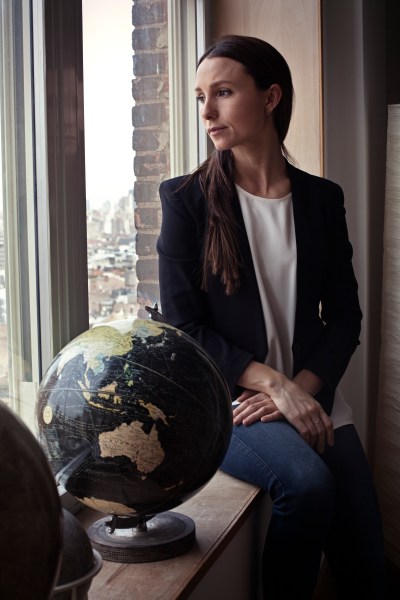
When she appeared in Jamie Johnson’s 2003 documentary Born Rich, 20-year-old Georgina Bloomberg was restrained, well spoken, and eager to make a separate name for herself. “I remember when my father first started campaigning, and I won a big class at a horse show. A few people from magazines wanted to interview me. I sat down and the first question they asked was about my father. That’s really what my struggle has been, to have people see the person behind that name.”
2015 will be a new start for Ms. Bloomberg, who has chosen to cultivate herself in the sport of equestrian jumping rather than while away her time choosing party outfits. Since the age of 6, the heiress has won titles including first place at the inaugural $210,000 Central Park Horse Show Grand Prix in September 2014. What started as an amateur hobby has morphed into a professional occupation, at press time, she was ranked No. 6 in the country. Jessica Springsteen was ranked ninth. It is likely that both will join the dressage, eventing and jumping teams for August 2016 in Rio.
Socially selective Ms. Bloomberg is not interested in mere photo opportunities though. Instead, she is cultivating a classic social reputation attending key, uber-upscale events to support charities run by her closest friends and offering her name to boost guest lists. She’s often seen alongside fellow heiress, Amanda Hearst, who heads her own Friends of Finn charity, campaigning against animal cruelty in puppy mills. Much like her father, Ms. Bloomberg is acquainted with holding court at these gatherings and is set to garner some serious front row attention from fashion pundits this year.
Fashion is close to Ms.Bloomberg’s heart. “I actually took a design course at Parsons, which I loved,” she confessed. However, “I realized that I do not want to be a fashion designer!” Instead, Ms. Bloomberg combined her interests in stylish attire and sport by founding a charity, Rider’s Closet, which collects and distributes gently used equestrian gear for schools and needy riders.
Home is a 20-acre farm in North Salem, N.Y., that formerly housed circus animals. Today it hosts the lucky ponies—and one rescued pot belly pig, Wilbur—who have fallen under Ms. Bloomberg’s care. All share the fresh air with the Bloomberg competitive horses. “Juvina’s my top horse right now, I’ve had her for about a year and a half,” says the horsey gal. “She is definitely the star of the team, but I always have some younger horses, too. I don’t want to go out and just buy a top horse. I like to raise and develop them either to ride myself or sell.”
To mix it up, Ms. Bloomberg jets down to Wellington, Fla., where she and boyfriend, fellow equestrian Ramiro Quintana, first met. The two have a son, Jasper, who just celebrated his first birthday. Jasper gave Georgina her most recent reason for a respite from the sport but she wants the world to know that she is now stepping up her public profile and career. “I’ve had enough times in my career where I’ve had a horse that’s injured, or I haven’t had a top horse, or I’ve been injured or had back problems or been pregnant so I’ve taken these breaks in my career,” Ms. Bloomberg admits, “but when I am competing and I’m healthy and have good horses and everything’s going well, that’s my No. 1 priority. It has to come first. Other projects will fall into place later in life.” — Zachary Weiss
THE NEXT BIG BURLESQUE ACT

With the rise of Dita von Teese and the smutified Lower East Side nightclub The Box, the cultural saturation level for neo-burlesque performance crested at least five years ago. One needs only to take a look at the revival of Cabaret on Broadway and the Fosse-cum-lately stylings of Ryan Murphy to glean that the high camp form of exotic dancing has become as quaintly mainstream as a night singing show tunes at Marie’s Crisis Cafe.
Luckily, there are still ladies (and a couple men) out there still willing to push the boundaries of convention with atypical offerings of undressing-as-performance. Francine The Lucid Dream has been producing and performing in a series called The Pink Room—based around the creepy works of auteur David Lynch—for the past four years, and doesn’t shy away from the difficult material. On a recent Saturday night, Francine and five other performers put on an interpretation of the director’s most ambitious failure, 1984’s Dune.
“It’s such an epically bizarre film,” said Francine, who began The Pink Room a few years back on the anniversary of Laura Palmer’s (fictional) death. “But think of all things we could spoof off of: people hearing voices, the ‘pain box,’ the sandworms! It’s hysterically funny, but also a tribute to all the epic costuming.”
For those more mainstream purveyors of pasties, The Pink Room will be holding its annual Miss Twin Peaks Pageant on January 31 at Joe’s Pub. — Drew Grant
THE NEXT BIG BRANIAC (OR FRANKENSTEIN)
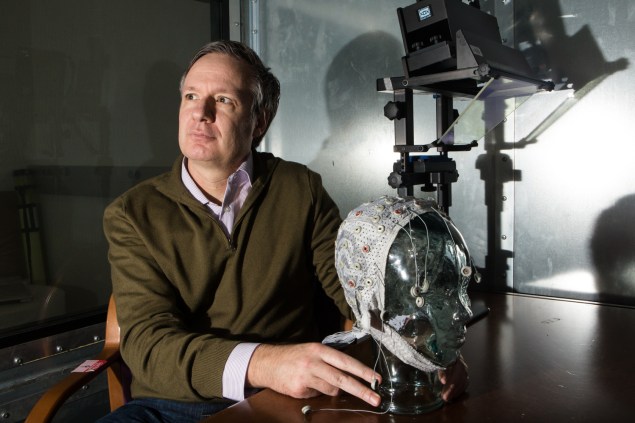
Cars that drive themselves, watches that can predict health problems before our doctors can—this is what many futurists promise is right around the corner. But to Dr. Paul Sajda, the head of Columbia University’s Laboratory for Intelligent Imaging and Neural Computing, none of these innovations will be very compelling unless humans and computers can become more intimate.
Mr. Sajda believes that if we could just give our machines a window into our brain waves—the fleeting thoughts we have before we even know we’re thinking them—we have a shot at that bold future where computers don’t just make our commodities and houses better; they make our brains better.
“The best coupling of man and machine,” said Mr. Sajda in his lab last month, “is when the machine knows something about the cognitive state of the individual.”
But maximizing the performance of Mr. Sajda’s inventions, which include a brain-computer interface (or BCI), requires the delicate matter of brain surgery “which not everybody wants,” he acknowledges, throwing up his hands.
For now, and the foreseeable future, Dr. Sajda contents himself with non-invasive sensors, primarily a electroencephalography machine, or EEG, a netted skullcap with 64 protruding wires that pick up the brain’s electrical activity. What you can get from an EEG worn on the scalp is a blurred version of a neuronal signal—not the exact signal itself.
Mr. Sajda is currently collaborating with the Defense Advanced Research Projects Agency (DARPA), to build a BCI that measures the neuronal activity of a pilot facing “pilot-induced oscillations”—when a plane perilously wobbles due to the overcorrection for turbulence. The technology should help pilots avoid such in-flight errors, which can lead to fatal accidents.
Skirting a student directing what appears to be a Roomba with a mounted camera across the floor of his lab, Mr. Sajda also co-founded Neuromatters, LLC, which, according to its website, uses “brain-imaging to research and predict instinctive and non-conscious consumer reactions to video content including TV and online video advertisements.”
The firm could force Hollywood and Madison Avenue to rethink focus groups as the primary research tool to understand audiences. It created a souped-up EEG called an Inter-Subject Correlation (ISC), which “measures how in sync audience members’ brainwaves are with each other.” According to the company, research shows that its technology can measure brain activity of a tiny sample and then “predict the reactions of very large audiences to marketing stimuli” with “astounding” accuracy.
Get ready for the next wave of subliminal ads.
'The best coupling of man and machine is when the machine knows something about the cognitive state of the individual.' |
Mr. Sajda also advises deCervo, a start-up launched by two of his students. The company uses “computer vision” to boost the batting average of baseball players by predicting the “Aha!” moment in a hitter’s brain as they make the snap decision about whether a pitch is a curve or fastball.
For hitters, identifying in those milliseconds the moment when they make decisions can be just as critical to their performance on the field as the decision itself. Brown University is already using a simplified version of the technology to train sluggers. “The sports world sees that as a potential game changer, or at least as a … scouting device,” said Mr. Sajda, a life-long Mets fan.
Mr. Sajda’s interest in neuroscience grew from a fascination with robotics. “My undergraduate thesis was a robot I taught how to yo-yo,” he said. Now, decades later, he thinks his work probing the brain can pay quick dividends. “Obviously if it was up to me,” he said hopefully, “I would love to see the Mets use [deCervo] and contend in 2015.” — Claire Cameron
THE NEXT BIG MOOD ELEVATOR
With today’s technology it is easier than ever to obsessively log every facet of existence, from calories consumed to number of steps per day. So where will the fixation with the so-called “Quantified Self” take us next? We’re betting on mood tracking.
The Observer recently tried out Mood Meter, a new 99-cent app to track our feelings. The ultimate goal: increase self-awareness and develop strategies to help us manage those feelings more effectively.
“Keeping a journal of your emotions is kind of tough, whereas having an app that records it for you makes it really accessible,” said Marc Brackett, director of the Yale Center for Emotional Intelligence and co-creator of Mood Meter.
During the trial, the app trained the Observer to articulate our emotions with unparalleled specificity. It let us choose from 100 different descriptors; never before had we differentiated between feeling “pleased,” “happy” and “joyful.”
Each mood was also categorized by color on a four-quadrant graph: yellow for high-energy, positive feelings (like “ecstatic”); green for low-energy, positive feelings (like “serene”); blue for low-energy, negative feelings (like “despair”); and red for high-energy, negative feelings (like “enraged”).
Ultimately, Mr. Brackett hopes users will learn to recognize their own emotions without having to plot them on the app. He offered an example of how it should work: “You’re going to make a phone call and you start thinking, ‘I’m in the blue right now, I’m tired,’ ” he said. “What am I going to do to get in the yellow, and be the best interviewer?”
His research has shown that people with better emotional awareness are more likely to achieve success in their social lives and in the workplace. “Emotional intelligence,” he wrote in Social and Personality Psychology Compass, “is hypothesized to influence the success with which employees interact with colleagues, the strategies they use to manage conflict and stress, and overall job performance.”
The same traits can improve classroom performance, believes Mr. Brackett, who co-created RULER, a project to teach emotional awareness to students. Around 1,000 schools throughout the country now provide students with the app.
Katie Orenstein, founder and CEO of the OpEd Project, has been plugging her emotions into Mood Meter for a year. “It gives me a broader language for my internal state of being,” Ms. Orenstein said. “It’s also kind of fun.”
Ms. Orenstein credits the app with several self-discoveries. A glass of wine with friends puts her “in the green.” A run speeds her into “the yellow.” And though her day-to-day life seems stressful, she realized her moods tend to be positive.
“I realized I have a short-lived relationship with [tension],” she explained. “The times that I feel it are much more memorable than lasting.”
By the end of our two-week trial run, Mood Meter had taught the Observer a few things, too: we tend to feel “blue” after lunch, and should try to go for mid-day walks; we’re at our most high-energy “yellow” around breakfast; like Ms. Orenstein, we’re “red” far less frequently than we think we are.
But one of our favorite aspects of Mood Meter was simply pausing and conducting an emotional self-exam.
Ms. Orenstein vocalized our sentiments the most accurately: “You’d think that when you’re well into your life, you’d know how you feel,” she said, “but you don’t.” — Jordyn Taylor
THE NEXT BIG THREAT
Though not a “classical” peril such as a dirty bomb or an anthrax letter, the hacking and disruption of the ever-expanding Internet of Things poses, in the analysis of Marie-Helene Maras, an associate professor at John Jay College of Criminal Justice, “one of the greatest security threats that we face.”
The Internet of Things refers to the increasing link between our various communication devices and our possessions like home appliances. For instance, it is common, and convenient, to set the DVR remotely from our smartphones to catch that episode of Girls. “Think about this,” said Ms. Maras, who last year wrote Computer Forensics: Cybercriminals, Laws and Evidence. “Many of the devices we use on a day-to-day basis are interconnected: wearable computers, mobile phones, tablets, smart TVs. The majority of them are cloud-connected, making them extremely vulnerable to cyber-threats.” Ms. Maras believes that security technology has not kept pace with our sophisticated personal mission control centers. “Convenience and the ease of use trumps security,” she said, adding that hackers tend not to find just one hard coded password, but gain access to “all of it.”
And while a hacker who filches our passwords or illicitly sneaks through the back door of an iPad could play havoc with the automatic garage opener or a light-dimming system, Ms. Maras worries more about pathological manipulation of pacemakers and ventilators. What happens if someone decides to “interfere with all these devices en masse?” she posits. “The changes of the settings of these devices can have catastrophic consequences.”
Ms. Maras is not alone in her concern. Europol’s recent Internet Organised Crime Threat Assessment warns that “with more objects being connected to the Internet and the creation of new types of critical infrastructure, we can expect … new forms of blackmailing and extortion schemes (e.g. ransomware for smart cars or smart homes), data theft, physical injury and possible death.” — David Wallis
THE NEXT BIG COCKTAIL

Nitecap isn’t the type of bar you’d expect to find on the boisterous corner of Essex and Rivington. It’s the sort of belowground speakeasy more often found in the cozy confines of the West Village—a retro-tinged parlor room bedecked with holly year round. But make no mistake; the bar can cook up a mean cocktail. And so we asked Nitecap’s mixologist Lauren Corriveau to feature one of her newest concoctions—a bracing explosion of florals and vegetals and aguardientes that is the aperitif known as Alternative Medicine.
“The Chareau is the secret weapon,” said Ms. Corriveau, rocketing a metal shaker back and forth beside her head as Elvis crooned on the hi-fi.
Chareau happens to be a delicious aloe vera liqueur. The herb-based Génépy des Alpes is in there too. No lie, this is booze that tastes downright healthy.
“We kind of felt there’s a hole in the market for these fresh flavors,” Ms. Corriveau went on. “It’s like going to the juice bar. But cheaper. And a lot more fun.” — Nate Freeman
THE NEXT BIG KVETCH
Knowing somebody who lives in New York brings with it a major perk—or so my friends like to think. Namely, that they can stay with me when they decide to visit. And how often they do! Distracting me from my weekend newspaper reading and wanting to walk the Brooklyn Bridge, a stream of guests circulate through my apartment as though it were a hostel. The thing is, I don’t like to leave the city—I subscribe to the words of John Updike, who wrote, “The true New Yorker secretly believes that people living anywhere else have to be, in some sense, kidding”—and even if I did, I’m not flying to Topeka. For what? The Tulip Festival? Perhaps you’ll get married someday. Then I’ll visit—and stay in a hotel. Put simply, I will not be on your couch (or AeroBed). So stop asking to be on mine. — Matthew Kassel
THE NEXT BIG JUDGE
Judge Pamela Chen is not exactly how most people picture a federal judge.
Judge Chen is the first gay Asian-American to serve on the federal bench. She’s 54, and looks younger, working in a courthouse where five of the lifetime-appointee judges are World War II veterans. Down to earth, she returned a reporter’s phone call with an informal and chipper, “Hi, it’s Pam Chen.”
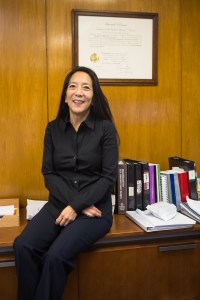
“I’ve had a charmed career,” she told the Observer in her Cadman Plaza chambers. She was confirmed by the U.S. Senate in March 2013—a “juggernaut” of a process she likened to the Japanese obstacle course television show Wipeout. She works in a courthouse suddenly thrust into the spotlight because its lead federal prosecutor, U.S. Attorney Loretta Lynch, has been tapped to be the nation’s next attorney general. Already Judge Chen has presided over two closely watched cases: a lawsuit over the NYPD’s alleged spying on Muslims, and the criminal trial against ex-Congressman Michael Grimm, who pleaded guilty last month to tax evasion. She will sentence Mr. Grimm in June.
A former civil rights prosecutor who’s worked on cases involving abortion clinic access and human trafficking, Judge Chen is used to attention. But it’s different overseeing a trial as a judge than arguing it as a lawyer. She is careful not to think aloud or come off as “glib or unfair,” she said.
Though she had worked in the federal courthouses for years, Judge Chen recalls that she didn’t know how to become a jurist. A colleague put her own name forward, inspiring Judge Chen to follow suit. She routinely emphasizes that anecdote when addressing women’s and Asian groups, who tend, she believes, to play down their accomplishments.
“I think there’s an assumption that if you work hard enough that someone will just … pluck you out of obscurity,” Judge Chen said. “And the reality—I’ve learned more so from being in this position now—is that people have to work at being noticed.”
While she does not believe in “diversity for diversity’s sake,” she allowed that being a “first” does spur confidence in the bench.
“I judge the same things as any of the other judges who are not Asians or women, but ultimately it does, I think, breed a greater amount of trust in the system from the people who come before us.”
With the U.S. Attorney from the Brooklyn federal courthouse heading to Washington, does Judge Chen have her sights on higher office? The Supreme Court perhaps?
“I am entirely focused,” she said of her lifetime appointment. “I am not looking anywhere beyond where I am—which means, lifetime—so that’s a lot of work between [now] and retirement.” — Jillian Jorgensen
THE NEXT BIG POLITICIAN
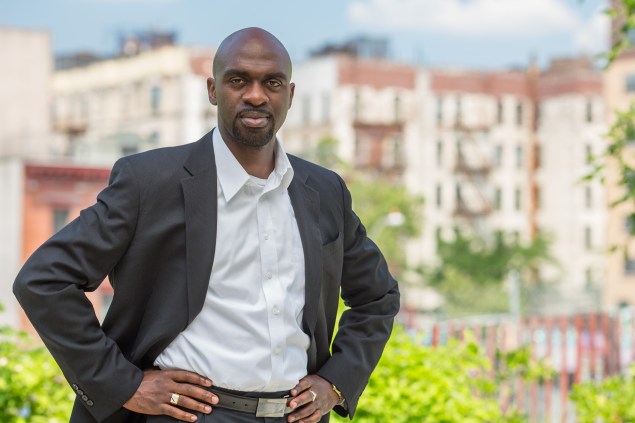
The Bronx is often where hope goes to die.
Unemployment is stubbornly high. Gun violence remains a real threat. Political corruption, a problem throughout the state, has infested the borough of late.
‘It’s about pushing, using the bully pulpit to bring resources to the South Bronx.’ |
But the Bronx, no longer burning, is now home to a young and ambitious political class that may be able to spruce up the borough’s image. One member of the Bronx young guns is Michael Blake, a former Obama campaign aide and White House staffer. Mr. Blake, 32, was elected to the State Assembly in 2014.
A Northwestern graduate and Bronx native, Mr. Blake, a Democrat, is optimistic that he can improve his South Bronx district.
“We have an opportunity now, looking at next year, to raise the minimum wage, pass the Dream Act and strengthen housing laws. We have an opportunity to have a transformative year in the legislature,” Mr. Blake told the Observer in December. “I have no doubt progress will move forward on the Assembly side.”
Mr. Blake’s constituents have plenty of reasons to be optimistic that he will serve them better than his predecessor, Eric Stevenson, the scion of a local political dynasty. Mr. Stevenson was found guilty last January of taking more than $20,000 in bribes from senior center developers and sentenced to three years in prison, joining a long list of Bronx elected officials who know the inside of a cell.
Defeating a Bronx Democratic Party-backed candidate and several other contenders to win his seat, Mr. Blake arrives in Albany owing few political favors. Though freshmen have little clout in a body in the firm grip of Sheldon Silver, the longtime speaker, Mr. Blake plans to bring change to his district right away.
“It’s about pushing, using the bully pulpit to bring resources to the South Bronx,” Mr. Blake said. “I’m aware people are looking toward me as the White House guy.”
Mr. Blake wants to bolster housing laws for tenants with rent laws set to expire in June, an uphill battle with the real estate industry-friendly Republicans in control of the State Senate. He also wants to combat gun violence in his district and make it easier for minorities to own small businesses.
“When you allow someone to have a job, they have hope,” Mr. Blake said. “This is a place that needs to be turned around. This is my responsibility.” —Ross Barkan
THE NEXT BIG COLOR
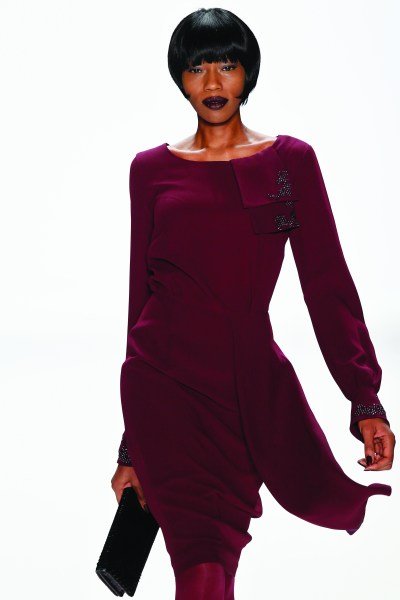
For Pantone, the Carlstadt, N.J., company that bills itself as “the global authority” on tints and tones, a new year means crowning an “it” color. So bid farewell to the quiet reign of 2014’s “Radiant Orchid,” a pinky purple, and welcome darker, richer Marsala.
Leatrice Eiseman, executive director of the Pantone Color Institute, believes that the earthy shade of red is “hearty, fulfilling and robust,” and represents the nation’s need for “stability and confidence.”
Yet the announcement of Pantone’s annual new color always stirs impassioned debate: Marsala has already been likened to everything from an old carpet to a “grimy, gag-inducing … dull brick,” according to The Atlantic. (The color evokes a pleasing vintage Port, in the estimation of the Observer.)
So how exactly does one identify the world’s next hot hue? According to Ms. Eiseman, color detectives, including herself, travel the world hunting for clues. When wine tones kept cropping up on the runways in Europe, Ms. Eiseman said, they knew they were onto something.
As for the Marsala haters, Pantone’s Ms. Eiseman seems unperturbed. “We don’t take negative opinions personally,” she said coolly. “The beauty of color is having an open mind.” — Lale Arikoglu


